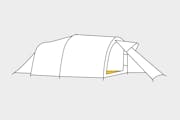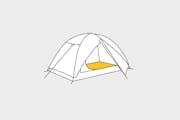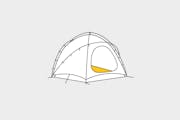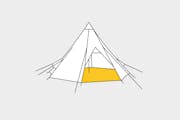Buying a tent: What you need to know
Do you use your tent in miserable conditions, rain or even snow? Or do you prefer to only go camping when the weather’s nice? Your answer determines the kind of tent you need for your adventure. Here’s an overview of the most important tent features.
Find the right tent for you!
Key questions to ask before making a purchase
Going camping in the great outdoors is always a wonderful experience. The following questions will help you decide on a suitable tent: it’s crucial that you buy a tent that works for you and your adventures.
Tent shapes
The different types of tent come in various sizes. You’ll find the pros and cons of each type of tent below.

Tunnel tents
Pros
Plenty of space: perfect ratio of weight to volume
Suitable for use as a family tent or for long trips with lots of luggage
Cons
The inner tent cannot be erected separately
The tent needs to be secured with pegs

Dome tents or igloo tents
Pros
Quick and easy to set up
Resistant to wind and bad weather
Lightweight
Inner tent stands up of its own accord, outside tent needs to be secured
Cons
Provides a comparatively small amount of room
Poor use of space (no straight walls in the inner tent)

Geodesic tents
Pros
The most resistant kind of tent currently on the market
Extremely stable in strong winds and extreme weather conditions, withstands snowfall
Also stands stable without being secured; the weight of the luggage holds the tent on the ground
Cons
More complicated to pitch than other tent types
Rather heavy, because very robust materials are required

Teepee tents
Pros
Plenty of space, sometimes enough height to stand upright
Room for lots of people, making it ideal for families or groups
Con
Takes a comparatively long time to set up, so it’s best for lengthy stays in one place
American and European forms of construction
When it comes to tents, there are basically two different kinds of structure: American and European. The tent types are available in various forms of construction, depending on the manufacturer.
European model
In the European variant, the outer and inner tent are connected to each other, with the pole channels running through the outer tent.
Pros: fast to erect, the inner tent does not get wet during set-up in the rain
Cons: inner tent cannot be pitched separately (or this can only be achieved with additional pole-holders).
American model
In tents featuring the American design, the poles are attached to the inner tent and the outer tent is stretched over this.
Pros: inner tent can be set up separately, the individual parts of the tent can be easily divided between several people for carrying.
Cons: erecting the tent takes a little longer than with the European structure and the inner tent can get wet if it rains during set-up. In addition, it is often a bit more difficult to secure, which is why it tends to flutter in the wind.
Climate zone and seasons
Various weather conditions can be expected depending on the climate zone or time of year – and that means your tent needs different features, too.
Materials used for tents
The standard material for tents is polyamide. But other materials are on offer – and they all have their pros and cons. Many of these fabrics are also available in mixed forms, such as cotton and polyester. In these instances, the properties of the materials are also combined.
Coating and waterproofing of tents
Outer tents are often coated with polyurethane (PU) or silicone to make them waterproof. PU is inexpensive to manufacture and abrasion-resistant. The seams are glued with tape. The PU coating ages faster and is less tear-resistant than a silicone coating.
Silicone coatings are high-quality, lightweight and durable – but more expensive.
In addition to the coating, tents can be ‘waterproofed’. While this does not make them fully waterproof, it ensures that the water beads off them. With time, intensified by the rays of the sun, weather and abrasion, the waterproofing decreases. The tent fabric then soaks up water and the tent becomes heavy and only dries slowly.
How often a tent needs to be re-waterproofed depends largely on how often it is used. You can easily waterproof your tent yourself.
Storage and care
Let your tent dry well before you put it away, otherwise mould will form. If you’re out and about, though, it’s perfectly fine if you take down the tent when wet and only dry it in the evening.
You should also remove any dirt. It’s not only nicer to put up a clean tent next time: this contributes to the longevity of your equipment, too. Sand, in particular, can damage the material if the grains rub against the coating. Clean the tent with just a cloth and some water; you can also use a soft brush on cotton tents. If the tent is very dirty, you can wash it by hand in the bathtub with special detergent. The mechanical impact of a washing machine would be too much and could damage the tent. Always follow the tent manufacturer’s guidelines as well as any instructions on the detergent.
Store your tent in a cool, dry place and away from sunlight. This latter point also applies outdoors: protect your tent from the sun, as the UV rays can damage the coating.
Do you have any questions?
Get personal advice from our sales advisors in the shops or online and over the phone from customer service. We'll be happy to help you.
- Free shipping from CHF 99
(With the TransaCard always free of charge)
- Secure payment with Twint, Visa and more
- 14 days cancellation right























































